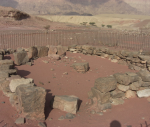You are here
South Syria flare-up presents security challenge for Jordan
Apr 24,2018 - Last updated at Apr 24,2018
A string of Russian statements on the future of Syria have reverberated across the region amidst rising tensions between Moscow and Washington following last week’s trilateral strikes against Syrian targets. The western strikes were in retaliation for an alleged chemical attack in Douma earlier this month, which was blamed on the regime.
Russian Foreign Minister Sergey Lavrov accused non-regional forces of attempting to dismember Syria and create a permanent military presence there. Stressing on the unity of Syria, Lavrov said that Moscow will not make concessions over such matter; adding that the Syrian conflict should be resolved based on the UN Security Council’s resolutions and in the framework of a political process led by Syrians.
A day earlier, on April 19, Russian Foreign Ministry spokeswoman Maria Zakharova claimed that the Syrian opposition, Jabhat Al Nusra and Daesh are attempting to create an autonomous authority in southern Syria. She said that “over the past several weeks, the situation in southern Syria has been deteriorating...” and that “convoys allegedly carrying humanitarian aid regularly arrive through the Jordanian border but we know what kind of ‘humanitarian aid’ that is.”
Furthermore, Zakharova said that Russia’s representatives to the joint monitoring centre in Amman have been informing Jordan and the United States of militant attacks on Syrian government units in these areas. She claimed that Al Nusra and other rebel groups are coordinating to launch a simultaneous offensive on Syrian government troops and then accuse the Syrian army of violating the ceasefire to justify their attack.
Lavrov’s statements and Zakharova’s claims have resonated in Jordan, a country that has a stake in preserving the de-escalation zone in southern Syria. Amman has been coordinating with Washington and Moscow to maintain the ceasefire in southwestern Syria. On April 21 a Jordanian Foreign Ministry spokesman said that Amman considers maintaining the de-escalation zone in southern Syria, agreed upon with Russia and the United States last November, as a priority. He added that the convoys that cross the borders from Jordan to Syria are international convoys carrying humanitarian aid for the Syrian people in accordance with UN resolutions.
Analysts agree that Jordan is worried that rising US-Russian tensions and the regime’s recapture of Eastern Ghouta could threaten the de-escalation zone in southern Syria. A number of analysts have speculated that the regime’s next military advance could be towards Daraa, a strategic province that is wedged between Jordan and Qunaitra; along the Israeli borders. But on Monday there were signs that the regime was now turning its attention towards the rebel-held pockets in the Homs and Hama countryside.
The three southern Syrian provinces of Daraa, Qunaitra and Sweida represent a unique geopolitical challenge. Free Syrian Army (FSA) groups control large swaths of Daraa and hold positions not far from regime troops. Al Nusra occupies positions in Qunaitra and is believed to be receiving military and humanitarian aid from Israel.
Daesh has about 700 well-armed fighters in the Yarmouk River basin, not far from Jordan’s northern borders. In Sweida thousands of fighters belonging to the pro-Jordan Tribal Army act as a buffer to prevent jihadist groups from infiltrating into the kingdom. And to the east, along the Syrian borders with Jordan and Iraq, US troops maintain presence in Al Tanf base.
Last year, the Trump administration suspended a CIA programme aimed at arming and training FSA fighters. Jordan has been trying, so far unsuccessfully, to use its sway over rebel groups in Daraa to hand over the Nasib border crossing to the regime. A flare-up in southern Syria would have unpredictable results for all. Amman fears a fresh influx of refugees, a possible infiltration by terror groups and an advance by pro-Iranian militias close to its borders.
Israeli calculations are similarly complicated. Following the Israeli strike on an Iranian-run drone airbase in Sweida on April 9, both countries have been trading warnings and threats. A collapse of the de-escalation zone in southern Syria could spiral tensions between the two enemies amid speculations that direct confrontation in Syria could be forthcoming.
Aside from Zakharova’s claim there has been no indication, so far, that the US was working to establish an autonomous region in southern Syria. Israel has been contemplating creating a “friendly” strip along its borders with Syria to act as a buffer against pro-Iranian militias. This would explain why it is cozying up to Al Nusra; a proxy of Al Qaeda.
It is not in the interest of Jordan to become a willing or even a reluctant accessory to any scheme that divides Syria or creates permanent areas of influence in the south, similar to what is evolving in northeastern Syria. Despite US President Donald Trump’s insistence that he wants a speedy withdrawal from Syria, Turkish President Recep Tayyip Erdogan accused the US this week of maintaining no less than 20 bases in Syria’s north.
While trying to preserve the status quo in the south for now, Amman is likely to be contemplating ways to pressure its allies in Daraa and Sweida to conclude reconciliation deals with the regime. A peaceful regime takeover of the southern border areas is an ideal way out for Amman from what is quickly becoming a national security nightmare. How the US and Israel would feel about that is another matter.
Osama Al Sharif is a journalist and political commentator based in Amman













